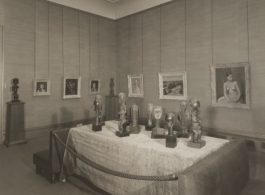May 2 – June 15, 2017
Press Preview, Tuesday, May 2nd, 10am – 11am
Opening Reception, Tuesday, May 2nd, 6pm – 8pm
Almine Rech Gallery New York is pleased to present Imaginary Ancestors, a group exhibition organized with Carlo Severi and Bernard de Grunne. Imaginary Ancestors looks at Primitivism [1] in modern and contemporary art, on the one hand restaging a seminal 1933 Durand-Ruel Gallery exhibition in New York of Fang sculptures and contemporary paintings of the time, and on the other hand presenting a parallel exhibition of Primitivist modern and affiliated contemporary works by Joe Bradley, Mark Grotjahn, Matthew Lutz-Kinoy, Ana Mendieta, James Turrell and Erika Verzutti, among others.
In Modernism, the search for the sublime and for imaginary origins have tended to coincide. For the modern artist – although Primitivist poetic choices often differed a great deal from one another – the Primitive was a new figure of the Antique. “The first man was an artist!” wrote Barnett Newman. From Derain to Kirchner, Pechstein, Matisse, and Picasso, the history of primitivism left its mark on the art of the last century. “These transfers of image may cause some surprise, but the evidence is convincing: the borrowings exist, undeniably.”[2] These ideas were definitively established in 1984, by William Rubin, when he organized the exhibition Primitivism in Twentieth Century Art, at the Museum of Modern Art in New York, which was accompanied by an important catalogue that remains a standard on the subject. In his essay, Rubin underscored the need for increased study of the primitivist influence, proclaiming, “No pivotal topic in twentieth-century art has received less serious attention than primitivism.”[3]
Today, Primitivism has changed its nature, but it refuses to leave the stage, and does not allow itself to be filed away in the archives of this century’s art. Instead of the search for imaginary origins, it conveys a multiplied image of a frontier, a constant and conscious conflict, which opposes cultural values and societies.
Imaginary Ancestors comprises two parts. The first room of the exhibition will present works by André Derain and Max Pechstein together with a restaging of the exhibition Early African Heads and Statues from the Gabon Pahouin Tribes. That landmark show was originally realized by Paul Guillaume at the Durand-Ruel Gallery on 57th Street in New York, from February 15 to March 10, 1933. This exhibition was the first show to be devoted to a single African art style, with a large group of Fang sculptures presented on a table alongside Derain paintings made at the time. For Imaginary Ancestors, renowned primitive art specialist Bernard de Grunne sourced the majority of the sculptures included in the original exhibition, which will be reunited for the first time since 1933 at Almine Rech Gallery. In the second room of the exhibition, modern and contemporary artworks inspired by primitive art will be shown with primitive pieces from the personal collections of Pablo Picasso, Alexander Calder and David Smith.
The exhibition is organized with leading anthropologist Carlo Severi. A catalogue will accompany the show, featuring new essays by Carlo Severi and Bernard de Grunne, as well as an interview with François Bellet.
About Carlo Severi
Carlo Severi is the Director of Studies at the Laboratoire d’anthropologie sociale, École des Hautes Études en Sciences Sociales (EHESS), and Director of Research at the Centre National de la Recherche Scientifique (CNRS), Paris, France. Severi has been nominated twice as a Getty Scholar (for 1994-95 and 2016-2017) at the Getty Research Institute, Los Angeles.
About Bernard de Grunne
Bernard de Grunne has been immersed in the world of great tribal sculpture for more than 40 years as he actively accompained his father Baudouin de Grunne in building one of the finest collections of Tribal Art in Europe from 1968 to 1995. He studied art of Congo under Dr. Albert Maesen Chief Curator of the Museum of Central Africa in Tervuren and earned a Ph.D. in African Art History with Professor Robet Faris Thomson at Yale University in 1987. From 1987 to 1992, he served as the worldwide head of the Tribal Art department at Sotheby’s. He started dealing for his own account in 1995 in African, Oceanic and Indonesian Tribal Art and has also published extensively on the arts of Eastern Congo, Nigeria and the styles of the Soninke and Dogon in Mali.
About François Bellet
François Bellet is a Picasso specialist who conducted the Picasso Estate inventory, including the African objects, from 1974 until 1981, and participated in the selection for the Musée Picasso Paris along with Dominique Bozo. He is now conservator of Fundación Almine y Bernard Ruiz-Picasso para el Arte.
[1] The term Primitivism is used to describe “the reference of modern artists to the art of the ‘primitives’, – an (…) ensemble of African, Asian or Oceanian objects, that both in Paris and elsewhere carried the name of art nègre at the beginning of the last century”, according to Carlo Severi in his article “Primitivist Empathy” (Art in Translation, Volume 4, Issue 1, 2012, pp.99-130, from the French “L’Empathie Primitiviste.” in Re-vues, 2008)
[2] Carlo Severi, “Paradoxes of Primitivism, Notes on Aesthetics and Anthropology”, in Jean-Hubert Martin, Partages d’exotismes, 2000.
[3] William Rubin, Primitivism in Twentieth Century Art. Affinity of the Tribal and the Modern. The Museum of Modern Art, New York, 1984.



